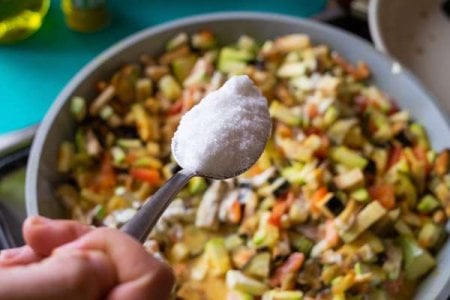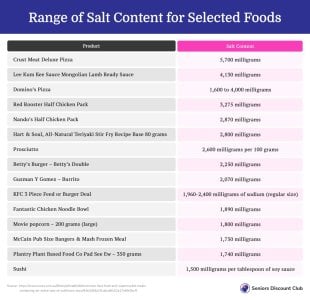How much salt is hiding in these everyday fast food and supermarket meals?
By
- Replies 19
While many people focus on the amount of sugar and fat they eat, salt content is one important but often neglected factor.
Eating too much salt has a major impact on health long term, alongside several side effects and potential risks.
These include weight gain, increased blood pressure, higher risks of heart disease and stroke for those who are salt sensitive, and a feeling of bloating and heaviness after a high-salt meal.
But what you may not know is just how much salt is actually present in many of the items we buy from the supermarket and fast food restaurants.
According to Nutritionist and Dietitian Susie Burell, the daily suggested amount of sodium intake is 2,000 milligrams (mg), whereas the average Australian has been found to consume almost double that target.
A great proportion of this excess salt can be found in many of the meals from cafes, restaurants and supermarkets.
For example, the ingredients on a Crust Meat Deluxe Pizza contain 5,700 mg of sodium. If you were to eat the whole pie in one sitting, you would be eating more than twice the recommended daily intake of sodium.
Even seemingly smaller portions can contain a lot of sodium, as seen with Lee Kum Kee’s Mongolian Lamb Ready Sauce. Even factoring in its four-person serving suggestion, it has a whopping 4,130 mg of sodium in just 120 g—over half the recommended daily intake.
Pizza toppings also contribute to salt content. Even has 2,800 mg of sodium in its 80-gram pack. But if you opt for a meaty feast like buffalo chicken, you could be consuming up to 4,000 mg of sodium, twice the recommended daily limit.
Popular fast-food options like Red Rooster’s Half Chicken Pack and Nando’s Half Chicken Pack may not be as healthy as they seem, with sodium levels exceeding 2,800 mg per meal.
Even when cooking at home, it’s important to be cautious of seasoning choices. Products like Hart & Soul's All-Natural Teriyaki Stir Fry contain a hefty 2,800 mg of salt, despite claims of ‘No Nasties.’
For those who enjoy charcuterie, a mere 100 grams of prosciutto can contribute to almost 2,600 mg of sodium to your platter.
When choosing fast-food burgers, a Betty’s Double Burger contains 2,250 mg of sodium. Mexican cuisine can also be sodium-heavy, with a single burrito from Guzman Y Gomez packing over 2,000 mg of salt.
KFC’s menu has salt content that ranges from 1,960 to 2,400 mg of sodium, while ready-to-eat meals can also be sodium-laden, such as the Fantastic Chicken Noodle Bowl with 1,890 mg of salt.
Even movie popcorn and plant-based options aren’t immune to high salt content, with 1,880 mg of salt for a large popcorn and 1,740 mg for Plantry Plant Based Food Co’s Pad See Ew.
Lastly, even seemingly innocuous soy sauce in your sushi contains 1,500 mg of sodium in just one tablespoon, making it turn from a seemingly healthy meal to a high-salt meal.
Below, you’ll find other fast food and supermarket meals along with the amounts of salt that they feature in each serve:
Excessive salt intake is linked to various health issues, including hypertension and heart disease, so it's crucial to be mindful of hidden sources of salt in seemingly healthy dishes.
To maintain a genuinely healthy meal, consider using low-sodium soy sauce or using it sparingly in your meal preparations.
A great way to monitor salt content is to check the packaging. If the amount of sodium per serve seems higher than the suggested daily intake, it could be a good idea to look for healthier alternatives.
You can also opt to dine out less frequently, as restaurants and processed foods often pack in excess sodium. Home-cooked meals with natural herbs and spices like rosemary, thyme, garlic, and oregano can help enhance the flavours in your dish.
Keeping the salt shaker out of reach during meals may also help you adjust to lower salt levels over time. These little changes can ultimately lead to a healthier life!

What are your tips and advice to avoid eating too much salt? Do you have salt-free recipes that you would like to share? Please let us know in the comments below!
Eating too much salt has a major impact on health long term, alongside several side effects and potential risks.
These include weight gain, increased blood pressure, higher risks of heart disease and stroke for those who are salt sensitive, and a feeling of bloating and heaviness after a high-salt meal.
According to Nutritionist and Dietitian Susie Burell, the daily suggested amount of sodium intake is 2,000 milligrams (mg), whereas the average Australian has been found to consume almost double that target.
A great proportion of this excess salt can be found in many of the meals from cafes, restaurants and supermarkets.
For example, the ingredients on a Crust Meat Deluxe Pizza contain 5,700 mg of sodium. If you were to eat the whole pie in one sitting, you would be eating more than twice the recommended daily intake of sodium.
Even seemingly smaller portions can contain a lot of sodium, as seen with Lee Kum Kee’s Mongolian Lamb Ready Sauce. Even factoring in its four-person serving suggestion, it has a whopping 4,130 mg of sodium in just 120 g—over half the recommended daily intake.
Popular fast-food options like Red Rooster’s Half Chicken Pack and Nando’s Half Chicken Pack may not be as healthy as they seem, with sodium levels exceeding 2,800 mg per meal.
Even when cooking at home, it’s important to be cautious of seasoning choices. Products like Hart & Soul's All-Natural Teriyaki Stir Fry contain a hefty 2,800 mg of salt, despite claims of ‘No Nasties.’
For those who enjoy charcuterie, a mere 100 grams of prosciutto can contribute to almost 2,600 mg of sodium to your platter.
KFC’s menu has salt content that ranges from 1,960 to 2,400 mg of sodium, while ready-to-eat meals can also be sodium-laden, such as the Fantastic Chicken Noodle Bowl with 1,890 mg of salt.
Even movie popcorn and plant-based options aren’t immune to high salt content, with 1,880 mg of salt for a large popcorn and 1,740 mg for Plantry Plant Based Food Co’s Pad See Ew.
Lastly, even seemingly innocuous soy sauce in your sushi contains 1,500 mg of sodium in just one tablespoon, making it turn from a seemingly healthy meal to a high-salt meal.
Below, you’ll find other fast food and supermarket meals along with the amounts of salt that they feature in each serve:
Excessive salt intake is linked to various health issues, including hypertension and heart disease, so it's crucial to be mindful of hidden sources of salt in seemingly healthy dishes.
To maintain a genuinely healthy meal, consider using low-sodium soy sauce or using it sparingly in your meal preparations.
A great way to monitor salt content is to check the packaging. If the amount of sodium per serve seems higher than the suggested daily intake, it could be a good idea to look for healthier alternatives.
You can also opt to dine out less frequently, as restaurants and processed foods often pack in excess sodium. Home-cooked meals with natural herbs and spices like rosemary, thyme, garlic, and oregano can help enhance the flavours in your dish.
Keeping the salt shaker out of reach during meals may also help you adjust to lower salt levels over time. These little changes can ultimately lead to a healthier life!
Key Takeaways
- Nutritionist and Dietitian Susan Burell says some popular fast food and supermarket meals have high salt content, posing potential health risks.
- Daily sodium intake should be 2,000 mg, but Australians are consuming almost double due to foods that are packed with salt such as Crust Meat Deluxe Pizza and Lee Kum Kee Sauce Mongolian Lamb Ready Sauce.
- Even food products marketed as healthier options, like Nando's and Red Rooster chicken packs, can have high sodium content due to the seasoning and sauces used.
- Products with seemingly healthy bases such as soy sauce can contain high amounts of salt, turning a seemingly healthy meal like sushi into a high-salt meal.
What are your tips and advice to avoid eating too much salt? Do you have salt-free recipes that you would like to share? Please let us know in the comments below!









